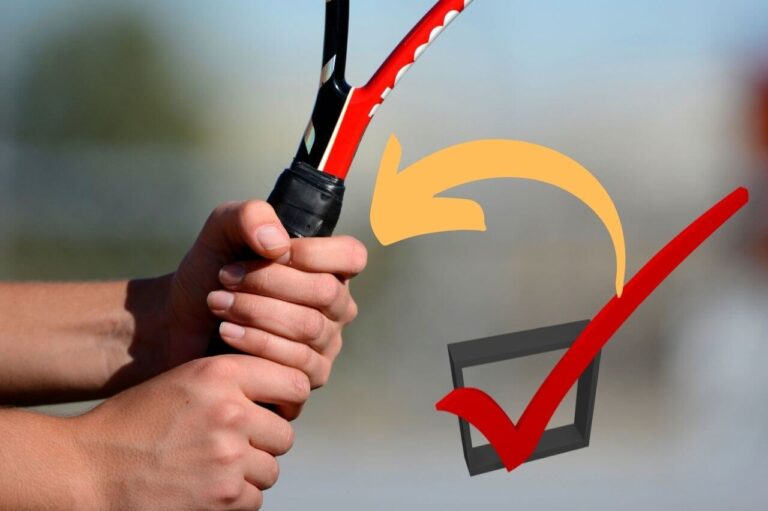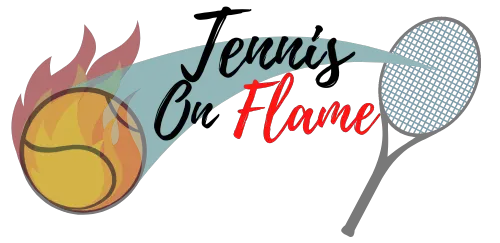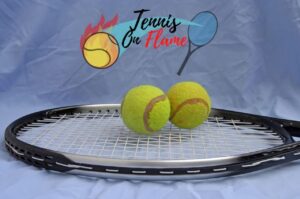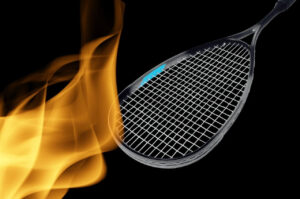How to hold a tennis racket when serving is a really good question – and as always, I’m here with all the information you need to know about serving!
Today, let’s delve into a crucial game aspect that can make or break your performance: how to hold a tennis racket when serving.
The serve is the first shot of any point, and nailing it can set the tone for the entire game. So, grab your racket, and let’s ace this guide!

The Foundation: Answering the Burning Question
So, how do you hold a tennis racket when serving? Right off the bat, let me give you the key to the game – it’s all about the grip.
How you hold your racket can significantly impact your serve’s power, accuracy, and spin. Now, let’s break it down step by step.
Getting a Grip on the Basics
Eastern Grip: The Traditional Touch
The Eastern grip is your go-to when you’re starting.
It’s a classic choice that provides a balance between control and power.
To nail this grip, place your index finger’s base knuckle on the racket handle’s third angle. Wrap your fingers around the handle, and you’re in Eastern heaven!
Why is this grip so crucial? It allows for a versatile serve, letting you mix up the pace and spin effortlessly.
Whether it’s a flat, slice, or kick serve, the Eastern grip has your back.
Continental Grip: The Ace’s Choice
For those seeking more power, the Continental grip is the MVP. Shift your hand slightly towards the first angle of the handle, positioning the base knuckle of your index finger there.
This grip provides a more natural upward motion, giving your serve extra oomph.
Why go Continental? This grip is the secret weapon for explosive serves, making it a favorite among professional players.
The Continental grip should be your best friend if you’re aiming for aces and overpowering shots.
The Nitty-Gritty Details
Hand Placement: Finding Your Sweet Spot
Once you’ve nailed your grip, it’s time to focus on hand placement.
Keep your non-dominant hand (left for right-handed players, and vice versa) on the racket’s throat, ensuring a stable and controlled motion. This hand will guide your racket throughout the serve, so finding the right balance is critical.
Wrist Action: The Silent Powerhouse
Now, let’s talk about the unsung hero – your wrist. Maintaining a relaxed yet firm wrist during the serve is crucial.
It allows for a smooth, fluid motion and helps generate that killer topspin or slice. Think of your wrist as the conductor, orchestrating the perfect symphony of power and precision.
Experimenting with Stances
Ready Position: Setting the Stage
Before you dive into the serve, your stance matters. A shoulder-width stance with your knees slightly bent ensures stability and agility.
Keep your weight evenly distributed between both feet, ready to explode into action.
Platform vs. Pinpoint Stance: Decoding the Mystery
Choosing between a platform and a pinpoint stance depends on your playing style.
The platform stance offers stability, ideal for beginners, while the pinpoint stance involves a small step with the front foot, adding a dash of flair and aggression to your serve.
Fine-Tuning Your Technique
Tossing the Ball: The Art of Precision
The serve’s success often hinges on the toss. Aim for consistency by tossing the ball slightly in front of your body and at a height where your racket can make contact comfortably.
Practice makes perfect – so spend time refining your toss until it becomes second nature.
Contact Point: Striking Gold
The magic happens at the contact point. For a flat serve, make contact slightly in front of your body.
For topspin, strike the ball when it’s a bit higher. Experiment with your contact point to find the sweet spot that suits your playing style.
Summing it Up: Acing the Game.
In conclusion, mastering the art of holding a tennis racket when serving is a game-changer.
The proper grip, hand placement, wrist action, stance, toss, and contact point all contribute to a killer serve. Remember, there’s no one-size-fits-all approach – it’s about finding what works best for you through practice and experimentation.
So, fellow tennis enthusiasts, grab your racket and hit the court with newfound knowledge. Let’s serve up some aces and make every game a winning game!
| Aspect | Recommended Grip | Key Point |
|---|---|---|
| Basic Grip | Eastern Grip | Offers a balance of control and power |
| Power Boost | Continental Grip | Provides extra power for explosive serves |
| Hand Placement | Non-dominant hand on the throat | Ensures stable and controlled motion |
| Wrist Action | Relaxed yet firm | Contributes to a smooth and powerful motion |
| Stance | Shoulder-width with knees slightly bent | Provides stability and agility |
| Serve Stance | Platform or Pinpoint | Choose based on your playing style |
| Tossing the Ball | Consistent and slightly in front | Key to a successful serve |
| Contact Point | Varies for different serves | Experiment to find your sweet spot |
Conclusion: Game, Set, Match!
There you have it, folks! A comprehensive guide on how to hold a tennis racket when serving.
Remember, the serve is your opening statement on the court; mastering it can elevate your game.
Experiment with the grips, fine-tune your technique, and, most importantly, enjoy becoming a serving maestro.
See you on the courts, and may your serves be ever in your favor!








